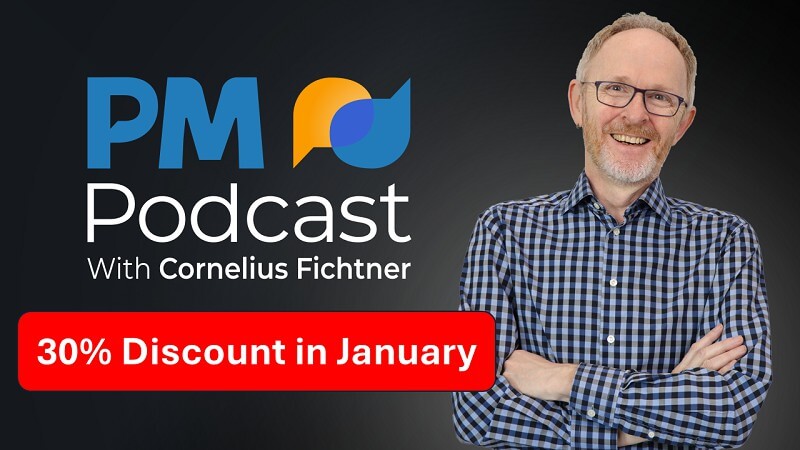Have you been asked to use Earned Value Management (EVM) on your projects or do you want to learn more about it? You're in the right place!
In this article we'll first cover an earned value management definition so you're clear on what it is, and then discuss EVM principles, metrics, best practices and earned value management systems.
EVM has its foundations in being able to monitor, track and control scope, schedule and budget on the project, and has been used by NASA and on projects like the delivery of Olympic parks. In our EVM resources you’ll find a range of topics relating to how to keep your project on track. New to EVM? Start with the featured podcast and you’ll pick up the basics in no time!
Article Contents
- An Introduction to Earned Value Management
- What is Earned Value Management?
- EVM in Project Management
- Earned Value Management: A Definition of Terms
- Earned Value Analysis (EVA)
- Earned Value Management System (EVMS)
- Essential Elements of EVM
- How to Calculate Earned Value
- Benefits of EVM
- Limitations of EVM
- How to Measure Earned Value Management for Project Performance
- EVM Best Practices
- PM Podcast Episodes for Earned Value Management.
- Summary
An Introduction to Earned Value Management
Listen now to this featured podcast for earned value management.
In this featured podcast you'll get a refresher on the basics with an introduction to earned value management on projects. By the end of this episode with host Cornelius Fichtner, you'll know how earned value came to be, how it works and you'll have a good understanding of its benefits and shortcomings.
If you've never used or even heard of earned value before, this is the place to start!

What is Earned Value Management?
Earned Value Management is a systematic approach to integrating and measuring cost, schedule and scope achievements at a project or task level. It’s a way of objectively understanding what is happening on the project so you can make data-driven decisions.
EVM in Project Management
EVM is an area of project management where many processes and knowledge areas link together. You need to understand scope management, cost management, schedule and time management, and the change control procedures that help manage scope creep. And you need to be able to interpret the data, so having a head for figures can help.
Of course, even if you aren’t mathematically-minded, you can still use EVM. There are processes and templates to help. Once you know the fundamentals, you can apply the principles to any project and interpret the results.
Earned Value Management: A Definition of Terms
Earned Value Analysis (EVA)
Earned Value Management System (EVMS)
Essential Elements of EVM
-
Scope management
-
Cost management
-
Schedule and time management
-
Change control procedures
Earned value in project management is an area where many processes and PM Knowledge Areas link together. You need to understand how to manage project scope, budgeting, scheduling and how to implement the procedures that help manage scope creep. And you need to be able to interpret the data, so having a head for figures can help.
Here's how those elements come into play when working out the metrics.
-
Scope managementThe building blocks of EVM are found in your approach to scope management: your scope items. You'll get these from the work breakdown structure for the project. It's essential that you have a detailed and accurate scope because delivering that is how you track progress and ultimately 'value'.
-
Cost managementThe next important element is cost management. For each scope item, you need to have a predicted budget. This is the charge or cost of each deliverable. You'll need a detailed budget that breaks down to component level so you can accurately track project spending against the anticipated levels.
-
Schedule and time managementNext, you'll need a detailed project schedule that includes all the scope items. Take a baseline of the project schedule and make sure that all the dependencies are included between the tasks. You'll use this as the timeline against which to track project progress.
-
Change control proceduresRealistically, every project changes something as it goes along. Your role as the project manager is to make sure those changes are adequately assessed and incorporated into the schedule and budget. You'll need change control procedures in place to do that. These are normally documented within your project management plan. With a clear process for dealing with changes, you can adapt and update any of your metrics and plans to ensure you are always tracking against the latest situation.
EVM is truly an area where the maxim ‘garbage in, garbage out’ holds true. You can only report and track real-time project performance measures where you have accurate underlying data. If your team members do not keep their task statuses up-to-date, or input their time spent on an activity, then you will have difficulty drawing conclusions from your EVM reports.
How to Calculate Earned Value
Planned Value (PV)
Planned Value (PV) is a simple starting point. It relates to the cost of the planned work. You may also see it referred to as Budgeted Cost of Work Scheduled (BCWS). Planned Value is measured in financial terms. The total PV for the entire project is called Budget at Completion (BAC). So you can see that the PV for a task is simply the budget for that task. You can calculate this by taking the cost for the Work Package or portion of the project you are looking at. If you need to calculate PV of a task that is part-way through, multiply the amount of progress by the budget. PV = task budget x percent complete.
For example, if a task is supposed to be 60% complete and has a budget of $10,000 then PV = $10,000 x 60% = $6,000.
Earned Value (EV)
‘Earned Value’ measures project progress. It’s a way of describing how much the work done so far is ‘worth’. Again, it's expressed in monetary terms so the result will always be a currency figure. You will also hear EV referred to as Budgeted Cost of Work Performed (BCWP), and that description (we think) makes it easier to understand what you are actually calculating.
EV is calculated by taking the percent complete of a Work Package and multiplying it by the budget for that activity. EV = % complete * BAC. Let's use the same example task as when we calculated PV to show the working.
The task is actually 40% complete and has a budget of $10,000. EV = $10,000 x 40% = $4,000.
Actual Cost (AC)
The actual cost is – as you would expect – a measure of how much of the budget has been spent during a certain time period.
There is no calculation for this: simply look at the budget spreadsheet and take the amount that has been spent.
Cost Variance (CV)
The Cost Variance tells you how much over or under budget you are at any given time.
The formula is CV = EV-AC .
Taking our sample task, if we know the EV is $4,000, we can work out the CV using the actual cost. Let's say the actual cost of the work so far is $2,000. CV = $4,000 - $2,000 = $2,000.
In this example, the result is positive, showing we are under the planned cost. In real life, you probably wouldn't see such a substantive cost variance but perhaps on this change initiative the team found a clever way to deliver the task cheaply!
That is EVM in summary! The indicators calculated let project managers compare actual progress to planned progress in monetary terms.
Don't worry if right now the formulas feel difficult. You'll soon get the hang of it, and it helps to have people to talk to about how to use EV in practice. Our forums offer lots of support and there's probably a student who has asked the same question you have, like this discussion on the difference between EV and AC.
Of course, even if you aren’t mathematically-minded, you can still use EVM. There are processes and templates to help. Once you know the fundamentals, you can apply the principles to any project and interpret the results.
Benefits of EVM
There are lots of advantages to using EVM on your programs. Here are the top benefits:
-
Predict project performance
-
Avoid scope creep
-
Forecast expenditure accurately
-
Communicate progress objectively
These are the kinds of benefit you might read in a proposal to bring Earned Value to the PMO, but what do they actually mean to you as a leader? Let's explain the advantages that this way of tracking progress can bring for you and the team.
-
Predict project performanceOne of the biggest advantages to using EVM to monitor project performance is that it can quickly alert you to trends. You can easily see if progress is slowing down so you can take corrective action in a timely manner. This is a huge benefit for a busy project or program manager because you've got objective, up-to-date data that is showing you the truth about performance and progress including how likely it is that you'll hit your ultimate milestones and budget.
-
Avoid scope creepYour value management system can help you avoid scope creep and reduce risk because it surfaces information to help you see what is going on in the project. What would happen if you approved that change and added extra requirements into scope? Metrics and EV reporting can help you model and predict whether or not you can still achieve your goals.
-
Forecast expenditure accuratelyYou'll see another benefit in forecasting and budget planning as well. This can be really useful to your capital investment and Finance teams because it helps them understand when the money will be leaving the business. They can better manage operational cash flow with that data, and your supplier invoices will be paid on time.
-
Communicate progress objectivelyA further benefit of Earned Value Management is that you can use the data to communicate progress in an objective way. This helps with ensuring people take accountability for their work and can focus the minds of executive stakeholders when it comes to decision making!
Limitations of EVM
The main limitations of EVM are:
-
It will tell you the variance but not what to do about it
-
Reporting is only as good as the underlying data
-
Stakeholders find the reporting complicated to understand
-
The process has limited use for Agile projects
-
There's no measure for quality
It will tell you the variance but not what to do about it
The output from your calculations will tell you there is a variance in the actual plan compared to what you had forecast. That's useful data, but it isn't the whole picture.
Let's face it: EVM is just math. The metrics still need to be interpreted, understood and acted on. You'll need to use your professional judgement for that.
Reporting is only as good as the underlying data
Your EVM analysis and information is only as good as the data you feed into the Earned Value Management formulas. There are many variables, and therefore plenty of places where the data analysis could go a little bit wrong. Your data has to be up-to-date and realistic to be any use. That might be difficult in teams where people are not used to reporting in real-time or measuring progress in this way.
In particular, timesheet data needs to be accurate and captured quickly so it can be fed into the system and used to calculate real progress. If your team doesn't track time today, moving to a system where they do have to measure the time spent on tasks could be a challenge -- let alone the additional overhead of introducing EVM principles.
Stakeholders find the reporting difficult to understand
OK, not all stakeholders will find the reports from EVM difficult to understand but some of them definitely will if they haven't used this kind of progress tracking before.
If you are going to use Earned Value Management techniques for tracking progress, it’s important to get buy in from stakeholders and team members. Often, people haven’t had exposure to this powerful way of measuring project performance. And you want them to support you implementing this new technique. Talk to them about the benefits of project control and how useful the data will be, and make the changes slowly and with support.
The process has limited use for Agile projects
In order to get the most out of the earned value tracking approach, you need a full work breakdown structure and full-costed budget as a baseline. Without those elements, your reporting isn't going to be much use.
You'll have those if you work in a predictive project environment that mainly follows the Waterfall approach to delivery. However, if you work on Agile projects, or even in a hybrid environment, you may not have enough concrete detail at the start of the project to feed into your EVMS.
That's not necessarily a problem. There are other tools you can use to track progress on Agile, iterative and hybrid projects. But don't try to use EVM and then wonder why the results aren't that good: it really does need you to have a clear plan that you intend to follow.
There's no measure for quality
The 'value' in earned value is to do with time and cost. The reporting focuses heavily on whether or not your work is on time and progressing to schedule, and hitting the expected financial targets.
In other words, the technique does not care much about quality. As long as you are on track and not overspending, your reports will look good. The results you are delivering could be low quality and failing to meet customer expectations, but EVM won't give you any indication of that.
You do have other ways to investigate and track project quality, as you will have documented in a quality management plan. You would also expect that if the deliverables are not fit for purpose, you'll see a lot of change requests coming through as stakeholders get to see parts of the project that are being delivered. However, it's worth bearing in mind that progress is not the same as quality and you will need other, proactive ways to satisfy yourself that what you are doing is delivering an output that meets stakeholder needs.
How to Measure Earned Value Management for Project Performance
Here’s a quick overview of the different steps involved in setting up a basic EVM framework for your project.
Step 1
Step 2
Step 3
Step 4
Step 5
Step 6
Step 7
Step 8
Step 9
Another hugely useful part of EVM comes into play here: you can use the data to forecast project performance. Based on the current performance, you can extrapolate the data and work out what your cost at completion is likely to be. Your project sponsor will find that information valuable because it helps inform decisions about whether the project is still viable and what the total expected budget is likely to be.
The same goes for timelines. Share the anticipated delivery dates with the customer so they are aware of any potential delays.
Step 10
EVM Best Practices
-
Use a Work Breakdown Structure to organize the project scope.
-
Create a logical schedule, with a hierarchical breakdown and adequate milestones.
-
Be ‘hands-on’ with managing the budget, making sure costs are allocated to time-boxed sections of the project.
-
Think about how you are going to measure progress so you can calculate the indicators effectively and consistently.
It’s time for singular ownership and accountability for organizational strategic planning and execution. It’s time for dedicated focus on organizational resource planning, allocation and utilization. It’s time for focused attention regarding return on investment, earned value on execution, appropriate risk management and post-execution benefit capture. And finally, it’s time for single-sourced, unambiguous communication regarding strategic balance, allocation of resources and prioritization of the directives that constitute the portfolio of investments that the organization makes on its own behalf.

PM Podcast Episodes for Earned Value Management.
Simple Earned Value Management for Your Project

Understanding Project Metrics

Planning and Controlling Mega Projects

Summary
Earned Value Management is often considered an advanced project management technique as it is not required on all projects. Many businesses choose to track project performance in other ways. Many executive stakeholders have never seen EVM reports before and are not sure how to interpret and use them.
However, EVM is a powerful tool for providing data to help decision making. It tracks performance like no other metric. Once you’ve made the move to earned value, you won’t look back!